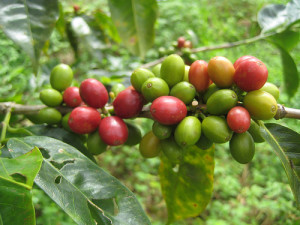by Michael Sheridan
 Michael Sheridan has worked on coffee for Catholic Relief Services since 2004. He currently directs the Borderlands Coffee Project in Colombia and Ecuador and advises other CRS coffee projects in Latin America and the Caribbean. He is based in Quito and publishes perspectives from the intersection of coffee and international development for the CRS Coffeelands Blog.
Michael Sheridan has worked on coffee for Catholic Relief Services since 2004. He currently directs the Borderlands Coffee Project in Colombia and Ecuador and advises other CRS coffee projects in Latin America and the Caribbean. He is based in Quito and publishes perspectives from the intersection of coffee and international development for the CRS Coffeelands Blog.
Over the past two weeks I have written about the coffee leaf rust epidemic that has decimated Colombia’s coffee production, and the response of the country’s coffee authorities, which includes financial incentives for farmers to plant the disease-resistant Castillo cultivar.
I have shared the results of a survey we conducted that may bring something novel to the discussion: smallholder perspectives on Castillo. And I have profiled our modest effort to expand the options available to smallholder farmers who need public financing for renovation.
Today, I conclude the series with some reflections on what we might learn from it all.
THE MOST IMPORTANT CONVERSATION IN SPECIALTY COFFEE?
Last month I published this post on what may be the most important conversation in specialty coffee: an honest, searching exchange among quality-driven roasters on the social impacts their businesses are having at origin. At this early stage, the discussion seems to be raising more questions than answers. In a lengthy passage in that post, I identify just a few of the most pressing questions I see in the debate over the social impacts of what James Hoffmann calls “the real stuff.”
What about coffees hitting 85 points or more on the SCAA scale and earning quality-based premiums? What about microlots that require special post-harvest technology, meticulous selection and separation efforts, and may never amount to more than 10 or 20 percent of a farmer’s total production? Certainly the price points are higher, but are they more profitable? Do they make sense for resource-constrained smallholder farmers, or would their scarce cash and labor be better invested elsewhere? Is the market for boutique coffees primarily for estates, or is it inclusive enough of smallholders to contribute broadly to community development and poverty reduction in the coffeelands? Are farmers translating improvements in coffee quality to corresponding improvements in their quality of life? Are quality standards in the marketplace rising faster than living standards at origin? Is there a point of diminishing returns beyond which additional investment to improve coffee quality fail to generate commensurate returns? If so, where does it lie?
There may be some answers to these questions in the rugged hills of Nariño, on Colombia’s southern border with Ecuador.
QUALITY or QUANTITY?
Nariño has long been recognized as a source of extraordinary coffee, but the results of the 2010 edition of Colombia’s Cup of Excellence made a resounding statement: lots from Nariño claimed the first six spots. And eight of the top 10. And 17 of 21 winning lots overall.
 With that kind of pedigree, you would expect Nariño to be the source of countless microlots. And indeed, roasters including Intelligentsia and PT’s, who cup ruthlessly to find coffee of surpassing quality, do source some small Direct Trade lots from Nariño.
With that kind of pedigree, you would expect Nariño to be the source of countless microlots. And indeed, roasters including Intelligentsia and PT’s, who cup ruthlessly to find coffee of surpassing quality, do source some small Direct Trade lots from Nariño.
But most of Nariño’s coffee goes to Nespresso and Starbucks through higher-volume sourcing channels that don’t include cup quality among the criteria that determine the price paid to farmers.
In this context, farmers face a clear choice between two very different business models. One creates strong financial incentives for quality and is to some extent agnostic about quantity: Direct Trade roasters are able to source lots of just a few dozen sacks provide the coffee that fills them meets their exacting quality standards. The other is not agnostic about quality — it does require that specialty quality standards are met and pays good prices — but creates stronger incentives for volume: the corporate roasters that dominate Nariño’s coffee trade are looking for hundreds of thousands of sacks. A farmer’s decision about which business model is best will have implications for the decisions she makes on the farm, beginning with the variety she decides to plant.
Castillo’s resistance to coffee leaf rust makes it the natural choice for farmers seeking to maximize yields.
And the preference among quality-focused roasters for non-hybridized varieties makes Caturra and other traditional cultivars the natural choice for farmers who seek access to the “boutique” segment of the specialty market.
Castillo can produce cup quality. Direct Trade roasters that participated in our Borderlands baseline survey scored some Castillo samples in the mid-80s, and the Intelligentsia lot from Nariño mentioned above included Castillo. But the same roasters that awarded Castillo samples scores as high as 86 points as part of our baseline also consistently preferred Caturra.
A THIRD WAY?
It may be that a smallholder’s best bet is not to choose quantity or quality, but to seek a blend of the two. Tom Owen of Sweet Maria’s puts forth a vision of a “third way” in this excellent thread on coffeed.com. He starts by acknowledging the precariousness of the Direct Trade sourcing model for smallholders:
We are already busting the farmer’s bank by asking them to separate tiny amounts of their best coffee, meticulously prepared, even with a price premium, when there is always a large bulk of coffee that falls into a lower quality level that we (meaning SM, but applicable to all roasters who work direct and pay best prices) can’t buy. The formula barely works now, and won’t in the future.
He suggests that what farmers need is “a quantity of quality.” And he advocates for a blend of quantity- and quality-oriented farming.
There’s a place for catimor [a hybrid variety created using Robusta genetics], honestly, at 1000 meters where plants are devastated by coffee rust fungus or other diseases, bourbon or typica or caturra would not survive, and wouldn’t cup well anyway. They should go for quantity there, and maybe they can max out at 84 points with the help of coffee quality research. But in places where good cultivars can be grown, the farmer needs to be presented with improved methods to maximize quality, distinguish this level of coffee from the lower grown arabica down the road, and get paid accordingly!
This approach to genetic diversification on the farm may in fact be the best way for smallholder farmers to manage both the production and market risk they face.
IN SUMMARY
Nariño is a natural laboratory for research into the returns to smallholder farmers on investments in different varieties and different market strategies.
There are farmers who are sticking stubbornly with Caturra. Others are moving gradually moving toward a full embrace of Castillo. Others are hedging their bets, keeping some of their farms planted in Caturra, incorporating Castillo and going back to the Colombia variety, a hybridized precursor to Castillo that is rust-resistant but has a better reputation for cup quality. Some are seeking to maximize yields while others are deliberately opting to invest in cup quality in the hope of developing new, more direct trading relationships.
We will track the incomes and “customer satisfaction” of farmers in each group through 2016 as part of our Borderlands Coffee Project research agenda, and report out here periodically on what we find — evidence that may inform the most important conversation in coffee.
– – – – –
This is the final post in a seven-part series titled “Colombia’s other eradication campaign.”
Michael Sheridan
Michael Sheridan is the Chief Executive Officer of the Coffee Quality Institute, a nonprofit organization with a mission to improve coffee quality and the lives of those who produce it. Sheridan has been leveraging market forces to make coffee work for smallholder farmers and farm workers since 2004. Most recently he directed progressive green coffee sourcing activities and direct-trade partnerships at Intelligentsia Coffee. Prior to that he worked to deliver initiatives in the coffee sector in Central and South America on behalf of Catholic Relief Services.






Comment